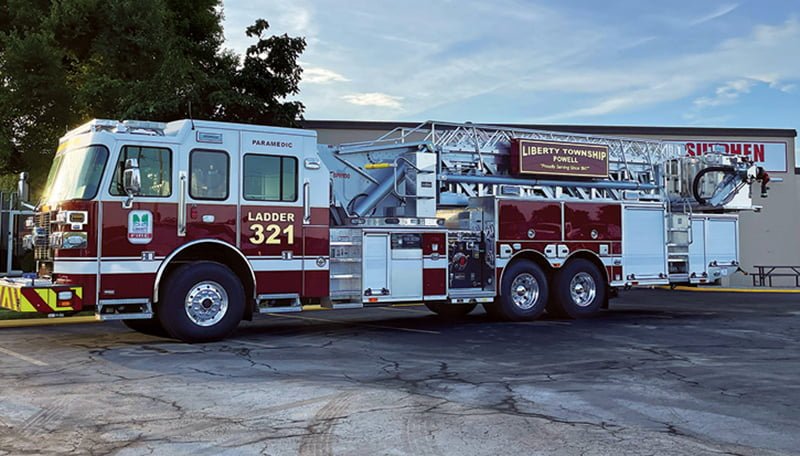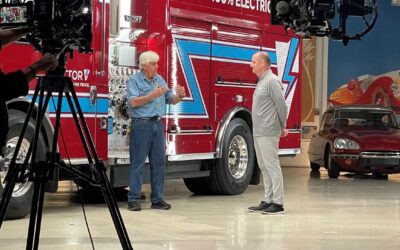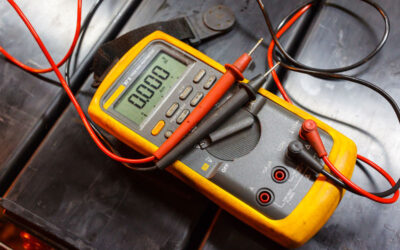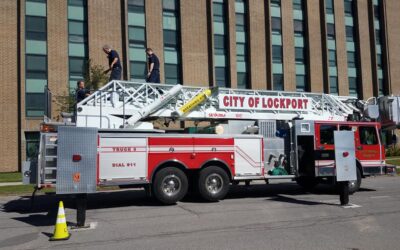The Liberty Township (OH) Fire Department is located southwest of Columbus and north of Cincinnati, covering a 37-square-mile district from two stations.
By Alan M. Petrillo
Its fleet consists of an engine, a rescue-pumper, an aerial ladder platform, and three advanced life support (ALS) ambulances, with the fire suppression rigs all built by Sutphen Corp. When it came time to retire the department’s 2004 Sutphen 110-foot Magnum aerial platform quint because of its age, Liberty Township again chose to go with a Sutphen aerial.
The rig that the department had Sutphen build is a SPH 100 aerial platform on a Sutphen Monarch heavy-duty custom chassis with a 73-inch four-door cab and 10-inch raised roof. “We decided to eliminate the water tank on the new vehicle,” says Duane Price, Liberty Township’s assistant chief and chairperson of its truck committee. “By not putting a water tank on the rig, we were able to carry three more ground ladders, which is important to us because we don’t always have the ability to get our aerial platform in front of a house or apartment building because of long, narrow driveways or long setbacks. We almost doubled the extension ladder capacity on the truck, which allows us to throw more ground ladders on a building.”
The new aerial platform carries one 35-foot two-section extension ladder, two 28-foot two-section extension ladders, two 24-foot two-section extension ladders, a 20-foot roof ladder, a 16-foot roof ladder, and two 10-foot folding attic ladders in two enclosed ladder tunnels and a 16-foot roof ladder affixed to the side of the aerial. “On our old platform, the ladders were carried on the outside of the rig,” Price notes, “but with the new truck, they are kept clean and out of the elements in the ladder tunnel.”
Price points out that the interior of the aerial platform’s cab matches those on its Sutphen engine and rescue-pumper. “The cab is set up for five firefighters,” he says, “with four of them in H.O. Bostrom self-contained breathing apparatus (SCBA) seats. There’s also a big emergency medical services (EMS) cabinet in the cab just inside the crew door on the road side that holds the paramedics’ EMS equipment, along with hazardous materials monitoring equipment and thermal imaging cameras.”
Andy Herb, president of Herb Fire Equipment, who sold the Sutphen aerial platform to Liberty Township, says the new truck’s huck bolt, 304 stainless-steel body was an important feature for the department, as was the ample amount of LED scene lighting installed on the rig. He notes that the vehicle is built on 10-inch double Domex brand frame rails, has a front axle and suspension rated at 24,000 pounds, and has a rear axle and suspension rated at 52,000 pounds.
The aerial platform is powered by a 500-horsepower (hp) Cummins X 12 diesel engine and an Allison 4000 EVS Gen 5 automatic transmission with a Leece Neville 320-amp alternator. The wheelbase on the vehicle is 247 inches, overall length is 48 feet, and overall height is 11 feet 6 inches. The rig has a Hale 2,000-gallon-per-minute (gpm) single-stage pump, two 2½-inch discharges on the left side, one 3-inch and one 2½-inch discharge on the right side, and a 1½-inch discharge in the extended front bumper.
Herb points out that the platform on the SPH 100 is 50 percent larger than that on the department’s previous Sutphen platform. “The two platform doors are slightly angled for easier egress,” he says, “and the platform will hold three firefighters comfortably, something that their previous bucket could not do.”
Other elements that Liberty Township wanted on the new truck include a transverse compartment under the cab’s seat risers where pike poles can be stored and a single-stack hosebed on the left of the ladder chutes to hold 400 feet of 3-inch hose, Herb says.
Price says that the aerial platform’s bucket has a parapet ladder feature, along with a rappelling and rope rescue fixture and a stokes basket fixture. “We carry a complement of rope rescue equipment for both high and low angle work,” he says, “along with a stokes basket and a Sked. While our rescue pumper carries all our battery-powered HURST Jaws of Life® eDraulic® rescue tools, on the aerial platform we carry a HURST Strong-Arm® combi tool that we use for forcible entry to pop doors and also for light auto rescue. The tool has two different tips and our firefighters love it.”
Herb says that the Liberty Township aerial platform has a grille-mounted Federal Q2B siren, a Voyager 3 camera system, a FRC ACT two-station intercom system, a Smart Power 10-kW generator, and two Hannay electric cord reels. The platform has an Akron Brass Company 1,250-gpm electric Stream Master 2 monitor on the driver’s side and an Akron 1,250-gpm manual Stream Master2 monitor and Akron 2499 and 3488 pipe on the officer’s side.
Lighting on the Sutphen aerial platform includes Whelen LED emergency lighting, a Whelen Freedom 72-inch LED light bar, a Whelen Mini 21-inch LED light bar, a Whelen Pioneer Summit 72-inch LED 12-volt brow light, FRC Spectra LED 12-volt scene lights, FRC Spectra LED 240-volt scene lights, and FRC Spectra LED 240-volt telescoping scene lights.






